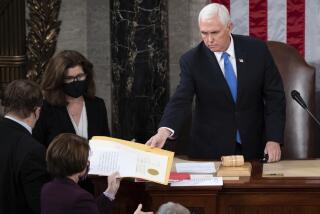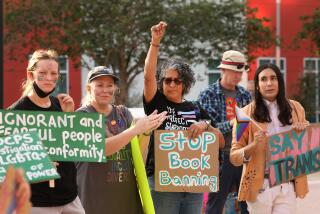Prosecutors End Rebuttal Phase in Simpson Trial
- Share via
Vividly demonstrating the strange hurly-burly that has overcome the murder trial of O.J. Simpson in its closing days, prosecutors rested their rebuttal case Monday even though Simpson’s lawyers have yet to conclude their main case.
In court, most of the day was devoted to a last exchange of blows over an FBI shoe print specialist who delivered important testimony for the prosecution and who sparred Monday with defense lawyer Barry Scheck. Having spent two days debunking the defense position that imprints at the crime scene might suggest a second assailant, Agent William Bodziak weathered Scheck’s sarcastic cross-examination, intended partly to embarrass the agent and partly to restore confidence in defense expert Henry Lee, whose testimony was the object of Bodziak’s criticism.
After Bodziak acknowledged that he could not recall Lee’s exact words on one subject, Scheck, his voice pitched and accusing, asked: “Isn’t it important, Agent Bodziak, to carefully review what another expert says if you’re going to come into court and criticize exactly what that expert says?”
Superior Court Judge Lance A. Ito did not even wait for prosecutors to object before cutting off that question.
“Do you think it would help to read a transcript?” Scheck then asked.
“Excuse me,” Ito interrupted, glaring ominously. “Counsel, counsel.”
Ito’s impatience with Scheck’s repetitive, detailed questioning was made obvious by his repeated and sharply worded interjections. And his weariness seemed shared by the jurors. One gazed around the room as the testimony unfolded a few feet from her, another stared at her nails, and one man bobbed back and forth in his chair.
That was merely the latest sign of tiring among jury members, several of whom chuckled appreciatively when Ito announced in court that one of his court reporters had been summoned for jury duty--”something I wouldn’t wish on anybody,” he commented.
Later, Ito said through a spokeswoman that he too had been summoned for jury duty, but had asked for it to be postponed.
Inside his own courtroom, the jury whose well-being has so preoccupied Ito took hardly any notes Monday, either during Scheck’s questioning or during brief follow-up examination by Deputy Dist. Atty. Marcia Clark.
In response to Clark’s questioning, the agent praised the Los Angeles Police Department for its crime scene photographs recording shoe prints and reiterated the central point of his testimony: that only one set of shoe prints appears at the scene.
“I don’t see any evidence from these photographs,” he said, “of other shoe impressions.”
With Bodziak’s appearance on the witness stand completed, prosecutors had called their last expected witness. Outside court, Simpson attorney Johnnie L. Cochran Jr. predicted testimony would conclude this week and closing arguments would commence next Tuesday--coincidentally, one year to the day from the time that jury selection began.
Before that, however, the defense has lined up a final list of last-minute witnesses, who it hopes to call to knock down the credibility of law enforcement officers who testified in the Simpson trial. Prosecutors are contesting virtually every one of them, arguing that some of their proposed testimony is unreliable and that all of it is irrelevant to the point of the trial: determining whether Simpson murdered Ronald Lyle Goldman and Nicole Brown Simpson on June 12, 1994. Simpson has pleaded not guilty.
Prosecutors unveiled their case against him nearly nine months ago, and before resting their rebuttal case, asked Ito to read one short statement to jurors that relates to the lighting on the night of the killings.
After raising the anticipation of drama by informing the jurors that they could regard what they were about to hear as undisputed, Ito then read the disappointingly dry statement.
“On June the 12th, 1994, the moon was waxing, with 12% of the moon’s surface illuminated,” Ito said.
Several jurors looked puzzled, so he read the statement again--still failing to wipe the mystified expressions off the faces of several panelists.
With that, Clark then announced that the prosecution was done with its case. Even that promise, however, was conditional, this time on the presentation of the remaining elements of the defense case, which under normal circumstances would have been concluded before the prosecution began presenting its rebuttal evidence.
‘No Shrinkage’
The Simpson team called the first of its so-called “sur-rebuttal” witnesses on Monday afternoon--those called to rebut the prosecution’s rebuttal case--putting him on the stand even though it technically has never rested its case-in-chief. That witness, Herbert MacDonell, testified earlier in the trial, and his return was opposed by prosecutors, who said they had presented nothing in their rebuttal case that he could respond to.
Defense attorney Peter Neufeld responded by saying that prosecutors had made an issue out of the size of gloves worn by Simpson during a series of football games from 1990 to 1993--a position that Ito accepted, allowing the professor to take the stand.
MacDonell, a folksy and easygoing witness who drew smiles and chuckles from the jury, performed an experiment with a similar pair of gloves to see how much they would shrink if covered in blood and allowed to dry.
Prosecutors, who blundered into allowing Simpson to try on the crime-scene gloves in front of the jury and then proclaim that they did not fit, have argued that part of the reason for that failed demonstration could be that the gloves had shrunk.
MacDonell, however, said that his experiment--which involved drawing blood from his own arm, smearing it on a pair of leather gloves and then testing their size before and after drying--suggested that the gloves did not shrink much, if at all.
“I would have to say negligible,” he said after describing his experiment. “I could detect no shrinkage.”
To illustrate the results of the experiment, MacDonell circulated color transparencies of the gloves before and after drying. Jurors looked carefully at them, passing them from person to person.
During MacDonell’s first appearance on the witness stand, Clark punished him with a confrontational cross-examination. This time, however, she approached him more gingerly, posing pointed but low-key questions.
From him, she elicited the information that the evidence gloves were frozen and unfrozen a number of times after being collected by police--treatment that she suggested might have affected their shrinkage. And, among other details, MacDonell acknowledged that he did not know whether the evidence gloves might have been worn out by years of wear and thus susceptible to shrinkage.
As she concluded her cross-examination, Clark fired a mischievous question. Reminding MacDonell of the pictures of Simpson wearing gloves at football games in the early 1990s--gloves that the prosecution maintains were the same ones found at the crime scene and Simpson’s house--Clark asked: “Did you test those gloves, sir?”
Neufeld jumped up to object, but for a moment could not articulate the reason. MacDonell said he had not tested those gloves, and though Ito eventually upheld Neufeld’s objections, Clark’s point was made, and she sat down smiling.
New Witnesses In Wings
Although MacDonell was allowed to testify Monday, prosecutors have objections to the balance of the defense’s remaining witnesses--particularly the testimony of two batches of people who the Simpson lawyers want to call in order to challenge the credibility of law enforcement officers who already have taken the stand.
The first defense effort is focused on FBI Agent Roger Martz, whose credibility the defense wants to attack by calling another FBI agent, Frederic Whitehurst, who has criticized his colleague and accused him of manipulating evidence in other cases. Attorneys spent the weekend questioning Whitehurst, and on Monday emerged with different accounts of what he would say if allowed to testify.
According to Deputy Dist. Atty. Brian Kelberg, Whitehurst’s comments “do not directly pertain to anything Mr. Martz did in the Simpson case. They deal with other allegations.”
But Robert Blasier, one of Simpson’s defense attorneys, responded that “there was a lot of discussion about this case.”
With the two sides telegraphing their positions regarding the propriety of Whitehurst testifying, Ito asked the defense and prosecution to review transcripts of Whitehurst’s weekend interviews and to be prepared to argue this morning over whether he should take the stand. Materials also are being delivered to the U.S. attorney’s office in Los Angeles, where Assistant U.S. Atty. Jeffrey Eglash will sift through the documents and bring them to court today, Kelberg said.
Although the Whitehurst issue poses potential problems for the prosecution, the defense’s other line of attack focuses on a far more important prosecution witness.
Cochran said the defense wanted to call an organized crime informant named C. Anthony Fiato, his brother and an FBI agent named Michael F. Wachs, a veteran organized crime investigator for the bureau. Those witnesses, sources said, would be called to testify that they heard Detective Philip L. Vannatter say that he and other officers went to Simpson’s house on the morning after the murders because they considered Simpson a suspect.
That would contradict Vannatter’s testimony, raising questions about his credibility and about the validity of the searches that he and other officers performed of the house and grounds that morning.
Cochran told Ito that he wanted to question Vannatter as early as this morning, but prosecutors indicated that they would pose an objection before allowing that to happen. Prosecutors last week turned over material to the defense relating to the Vannatter issue, a move they said they took “out of an abundance of caution” to ensure that evidence-sharing rules were complied with.
Ito has yet to rule on whether the defense can call those witnesses, and though he agreed to take home some material related to those issues, he cautioned the lawyers that he had a minor crisis of his own to deal with: The judge said that the pump for his fishpond had quit on him.
“If I don’t get a new pump,” he remarked after the jury had left for the day, “I am in trouble.”
Nevertheless, Ito expects to hear arguments and make rulings on those proposed witnesses in the next day or so. Those rulings will chart the remaining course of the trial, which both sides now anticipate will go to the jury sometime in the next week or two.
Although those particular questions remained unresolved, the judge did rule on one other proposed line of defense. Cochran announced Monday that Simpson’s lawyers wanted to call Sherry M. Ray, a Los Angeles police officer who worked with Fuhrman and who now is off duty on a stress leave.
According to Cochran, Ray would testify that Fuhrman used a racial epithet in her presence, that he boasted of falsifying official police records and that he talked about fabricating evidence against African Americans.
Prosecutors argued, however, that Fuhrman’s racism already is well-established and that another witness can’t add to the jury’s sense of that. Moreover, said Deputy Dist. Atty. Cheri Lewis, the defense never has offered evidence to suggest that Fuhrman planted the bloody glove outside Simpson’s house, so testimony about his willingness to fabricate evidence in other cases would be irrelevant.
Ito agreed, ruling that Officer Ray cannot be called to testify.
* NEW DEFENSE MOVE: Defense wants former Mafia muscleman to testify. A20
More to Read
Sign up for Essential California
The most important California stories and recommendations in your inbox every morning.
You may occasionally receive promotional content from the Los Angeles Times.











